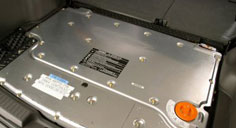As we continue to work on producing cleaner and more fuel-efficient vehicles, the study of battery technology has gained momentum. Advances in battery technology will allow us to further improve hybrid systems and pave the way for other electric propulsion systems.

A Cleaner Way to Drive
The primary advantage of a hybrid is better fuel economy, but there are significant emissions benefits as well: hybrids have lower tailpipe emissions and emit fewer greenhouse gases than conventional vehicles because of their ability to drive in electric-only mode. And by increasing fuel efficiency, these vehicles also reduce reliance on foreign energy sources.
Hybrid Batteries
Although batteries have been used to power vehicle accessories and even propel entire vehicles for many years, the high-voltage batteries used in hybrid vehicles are still considered a relatively new technology, and as a result, they're costly. Low volumes, lack of commonality in battery configurations among automakers and limited battery suppliers are all contributing factors to the higher price tag.
In addition to cost, there's also customer concern regarding the robustness and durability of hybrid battery systems. Questions about battery life are the most frequently asked by potential hybrid customers.
2004 Escape Hybrid
When we designed the 2004 Escape Hybrid, we produced a highly sophisticated and reliable battery system capable of working for 10 years and 150,000 miles. The work we did on the 2004 Escape Hybrid became the benchmark for evaluating battery life capability in our next-generation hybrid vehicles, as well as providing a methodology for evaluating and comparing alternative battery technologies both for hybrid and fuel cell vehicle applications.
Battery Innovation
Nickel metal hydride (NiMH) batteries are preferable for use in today's hybrid vehicles. However, because of chemistry constraints, there is not much room for improving NiMH energy and/or power density. In addition, as volumes rise beyond several hundred thousand units, NiMH batteries become uncompetitive in terms of cost with other batteries due in most part to their large nickel content.
For near and mid-term automotive applications, Lithium-ion (Li-ion) batteries are the most promising alternative. Li-ion batteries use much less nickel and have significantly more energy and power than NiMH batteries. The use of nanomaterials, smart materials design and good cell engineering should further enable the development of these higher power cells.
The primary concern with Li-ion batteries is that they can become overcharged or internally shorted. To prevent this, we've found that using an external control system is effective in maintaining the proper state-of-charge of the cells in the battery pack.
Although Li-ion batteries seem to have a promising future, cost once again plays a part. Presently, Li-ion batteries are too expensive for mass-market automotive applications. The United States Automotive Battery Consortium (USABC), a collaboration involving domestic automakers (including DaimlerChrysler, Ford and GM) and the U.S. Government, is working toward established cost targets.
The Future
We believe that not only are advancements in batteries important for current hybrid applications, but they're also key enablers for future technologies like plug-in hybrids, battery electric vehicles and fuel cell vehicles.
Customer acceptance will also play a role in the future of battery technology. As customers weigh the costs and benefits associated with owning hybrid vehicles, their concerns about durability, battery replacement and safety must be addressed.
Recycling Batteries
Due to the high cost of these batteries and the environmental concerns associated with throwing them away, simple one-time use and disposal is unacceptable.
We believe these batteries need to be designed to be easily and economically collected, reused, reprocessed and recycled. Currently, the infrastructure for recycling Li-ion batteries from consumer electronic devices is only in its early stages of development, but the USABC has been developing a strategy to make recycling easier through efficient identification, disassembly, reuse, remanufacture and recovery of spent batteries.

